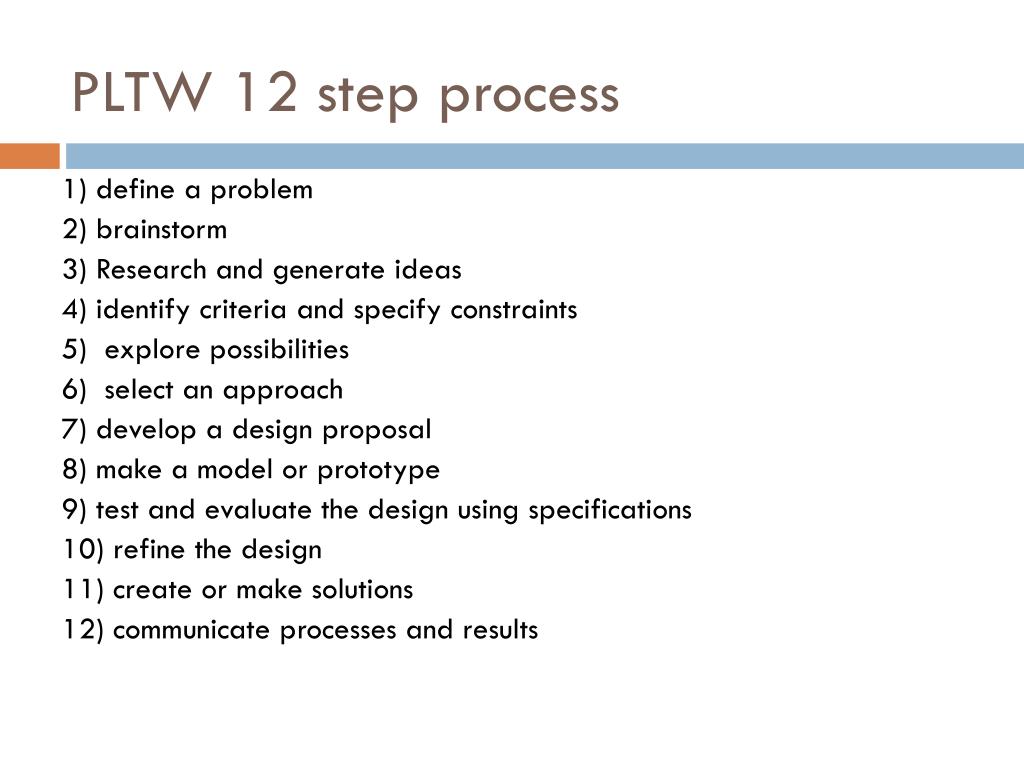Table Of Content
Students learn how these concepts apply to a career in aerospace engineering and other engineering fields. The knowledge and skills students acquire throughout PLTW Engineering come together in EDD as they identify an issue and then research, design, and test a solution, ultimately presenting their solution to a panel of engineers. Students apply the professional skills they have developed to document a design process to standards, completing EDD ready to take on any post-secondary program or career. Students are given the opportunity to combine mechanisms with input and output devices to automate the mechanisms. Construction and programming skills are layered, and projects and the problem provide students the opportunity to connect their learning throughout the lessons in the unit. Students take on the role of interns, and work in teams to identify design requirements and create prototypes to meet the needs of clients.
Years of PLTW's Introduction to Engineering Design
They solve real-world aviation and space challenges and plan a mission to Mars. To ensure that more middle school students have equal access and opportunities to engage and be empowered through the PLTW experience, we offer all PLTW Gateway units and teacher resources in both English and Spanish. PLTW Core Training immerses teachers in a hands-on, collaborative learning environment, challenges them to look at their classrooms in a new way, and empowers them to bring learning to life with PLTW. Physical computing projects will promote student awareness of interactive systems, including Internet of Things (IoT) devices, and broaden their understanding of abstract computer science concepts through meaningful and authentic applications. Students discover the design process and develop an understanding of the influence of creativity and innovation in their lives.
PLTW Gateway Pricing
They also explore robot systems through projects such as remotely operated vehicles. Students explore the physics of flight and space through software simulations and hands-on experiences. They bring concepts to life by designing and testing an airfoil, propulsion system, and a rocket.
Engineering Design Process Comes to Life
It’s been amazing to see this giant, successful program continue to grow and improve, knowing I was one of the original pieces of the puzzle. The PLTW Participation Fee is invoiced annually and does not increase with added units or program expansion.
Explore Our Curriculum
PLTW Engineering students adopt a problem-solving mindset, are engaged in compelling, real-world challenges that help them become better collaborators and thinkers, and are prepared with skills to step into any career path they take. I hope you received some ideas to help you as you make your way through the process of developing partnerships. Business partnerships are a key way to increase your PLTW program’s funding as well as provide students a way to interact with companies. Students are engaged in compelling, real-world challenges and are prepared with skills to step into any career path they take. PLTW Launch taps into students’ exploratory nature, engages them in learning that feels like play, and encourages them to keep discovering. Students at Dakota Meadows Middle School in Mankato, Minnesota, have been working diligently to design, build, test, document, and share puzzle cubes in Michael Schuldt’s classroom.
Teacher-Empowered Curriculum for a STEM-Driven World
Maple PLTW Students Thoughtfully Create Therapeutic Toy Design For Classmates - Journal & Topics Newspapers Online
Maple PLTW Students Thoughtfully Create Therapeutic Toy Design For Classmates.
Posted: Fri, 07 Jun 2019 07:00:00 GMT [source]
In PLTW Engineering, students engage in open-ended problem solving, learn and apply the engineering design process, and use the same industry-leading technology and software as are used in the world’s top companies. Students dig deep into the engineering design process, applying math, science, and engineering standards to hands-on projects. They work both individually and in teams to design solutions to a variety of problems using 3D modeling software, and use an engineering notebook to document their work. This course propels students’ learning in the fundamentals of atmospheric and space flight. As they explore the physics of flight, students bring the concepts to life by designing an airfoil, propulsion system, and rockets.
Students will customize their experience by choosing a problem that interests them from the areas of health, environment, emergency preparedness, education, community service, and school culture. Because problems in the real world involve more than one discipline, the unit will introduce students to biomedical science concepts as they work on solutions for the specific problems they choose to tackle. Students engage in an open-ended research experience in the PLTW Capstone course, a culminating program for those completing PLTW's high school offerings. They collaborate in teams, designing and developing original solutions to well-defined and justified real-world problems. Students explore the foundations of computing by engaging in circuit design processes to create combinational logic and sequential logic (memory) as electrical engineers do in industry. Students discover and explore manufacturing processes, product design, robotics, and automation, and then they apply what they have learned to design solutions for real-world manufacturing problems.

In 1996, my boss at the time, Dick Blais, left the district to work on getting PLTW off the ground. He had put together a very powerful advisory council that met frequently and helped raise the initial funding for PLTW, which got its start in 1997. Students play the role of real-life medical detectives as they collect and analyze medical data to diagnose disease. They solve medical mysteries through hands-on projects and labs, measure and interpret vital signs, examine nervous system structure and function, and investigate disease outbreaks. Our programs are designed to empower students to thrive in an evolving world.
WVU Today WVU's Project Lead The Way training builds foundation for students to reach national conference - WVU Today
WVU Today WVU's Project Lead The Way training builds foundation for students to reach national conference.
Posted: Wed, 04 Oct 2017 07:00:00 GMT [source]
Many students have come back after college and thanked me for turning them on to a successful career in engineering. They will usually also bring up a favorite PLTW project from our class time together. Terry C. Nagy Jr. is a longtime teacher at Shenendehowa High School, located in the New York school district where the first PLTW courses were developed two decades ago.
People like to hear success stories, so use this data to show how you are impacting students with these partnerships. Most of the time, if your design includes all components of what you are looking for from your future partnership, it will have a greater chance for success. He has worked in Career and Technical Education (CTE) for 10 years, first as a teacher and now as an assistant principal working with Denver Public Schools. Bradley’s passion is promoting STEM programs and education to girls and students of color. After the training, the group decided to keep in close contact and met at least once a month to have everyone contribute what they and their PLTW students were picking up.
It worked great – we were able to keep in touch and share our experiences. In addition, there were several members of the group who took leadership roles and ended up being the first Master Teachers in IED. In the early ‘90s, before PLTW officially formed, teachers at my school taught early versions of IED, Principles of Engineering (POE), and Digital Electronics (DE).

No comments:
Post a Comment